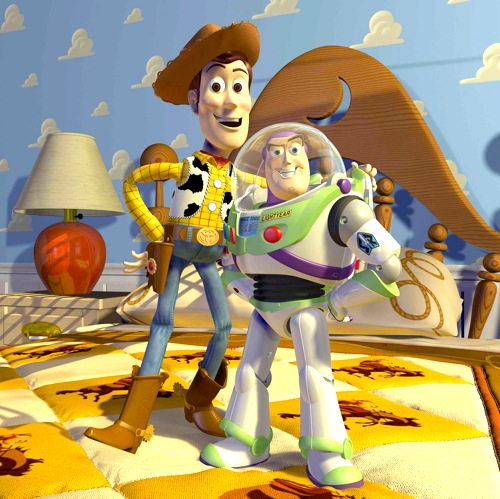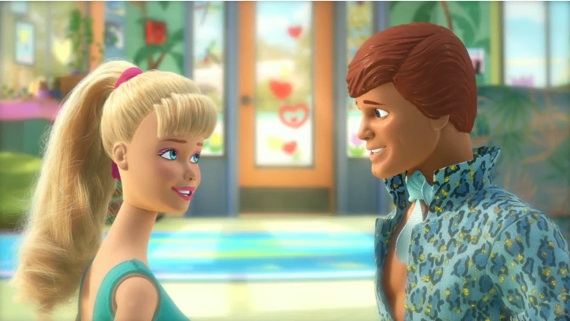[Editor’s Note: Jason Apuzzo has decided to review Inception upside down. If you are unable to grasp the complex paradox this represents, it’s possible that you are simply a philistine.]
Posted on July 16th, 2010 at 11:43pm.
By David Ross. Pixar vs. Faux-Pixar is the duel at the local megaplex this summer, as Universal Studio’s Despicable Me and Dreamworks’ Megamind square off against Pixar’s Toy Story 3. In the end, there can be no real contest. Pixar is a genuine American classic, a creative serendipity feeding as directly and undeniably into the permanent culture as the Wright Brothers’ bicycle shop or Frank Lloyd Wright’s Taliesin West. Pixar’s few corporate peers are Levi’s, Winchester, Harley-Davidson, Topps, Fender – companies that have found forms somehow expressive of the national spirit. Pixar stands athwart the cynical, noisy, sexualized nonsense of the mall culture, and says, effectively, “None of this is necessary.”
Toy Story 3 is steeped in heart and soul and memory, with time itself – as in all the greatest works – somehow the nemesis. It arguably tops the previousToy Story installments and The Incredibles – masterpieces in their own right – and exemplifies as well as anything what American companies are capable of creating when they heed their better angels.

The story is simple enough. Andy is leaving for college. He’s decided to take Woody with him (a detail full of wonderful sentimental implication), while the rest of the gang are grumblingly headed to the attic in a garbage bag. A mix-up lands the bag at the curb with the rest of the trash. Led by Buzz Lightyear, the toys escape their polyethylene tomb, scamper into the family car, and climb into a box destined for the Sunnyside Daycare Center. This turns out to be a militarized police state run by an emotionally warped teddy bear named Lotso and his henchman (“Authority should derive from the consent of the governed, not from the threat of force!” declares Barbie, echoing Thomas Jefferson). Woody must, of course, save his friends and find his way home in time to depart with Andy. There ensues the mother of all prison-break sequences, a careening, antic homage to The Grand Illusion, Stalag 17, and Bresson’s A Man Escaped. It is certainly the first scene of its type to pivot on the availability of a tortilla, or to require the Scotch-taping of a cymbal-playing monkey. In the end, suffice it to say, the film affirms the values of friendship and loyalty; gracefully negotiates Andy’s passage to adulthood; and looks kindly on the cycling of the generations – the essence of cultural health – as Andy’s toys pass lovingly into younger hands.
Pixar never engages in the crass partisan whining of a film like Avatar (“shock and awe,” etc.), but each of Pixar’s films contains the gentlest and least intrusive suggestion of a guiding conservatism, it seems to me. The governing ideas are something like: 1) What was good then, is good now; 2) Each of us has duties that we must determine and fulfill; 3) Memory is the essence of our humanity; 4) Capitalism does not destroy, but creates culture – not necessarily a high culture, but a culture worth loving; 5) There are leaders and followers – natural, organic, unenforced hierarchies – and we must each assess and accept our place, 6) In time of trouble, the cowboy and spaceman – embodiments of the heroic aspiration I discussed here – will see us through. Toy Story 3 is, to my mind, precisely what a conservative film should be: a demonstration of certain virtues and laws of nature, which the wise can interpret and apply as they see fit.
The film has plenty of fun with the metrosexuality of Ken (doesn’t Mattel have lawyers?), but its more meaningful dig at the Blue State geist involves Lotso. Once a little girl’s beloved companion, he was accidentally left behind at a picnic in the countryside; he valiantly journeyed back to his house only to find that he had been replaced by another bear exactly like himself. In his heartbreak, he became bitter, cynical, alienated … as George W. Bush would say, evil.

Your typical Hollywood simpletons would proceed as programmed to a trite conversion scene, on the assumption that all humans are essentially good and can be reclaimed with a hug. Pixar has no patience with touchy-feely delusions about human nature. The climax of the film finds the whole gang on a conveyor belt headed toward a pair of whirling metal teeth (the scene reverses the usual environmentalist fanfare of rainbows and dancing flowers; recycling has never been conceived so menacingly). Woody risks his life to free the trapped Lotso, and they narrowly avoid death by mastication. With the gang now headed toward a demonic abyss of fire, Woody points Lot-so toward a big red stop button. Woody assumes, just as we assume, that Lotso, having been touched by the magic wand of love, is now a good guy. But no! Without the least hesitation, Lotso sends the whole gang into the fiery maw of hell (rescue arrives from other quarters). The point seems to be that some people really are evil and we had best take their evil seriously. If only the proponents of the “Overseas Contingency Operation” and “Man-Caused Disasters” had the wisdom of Pixar!
As in all the Toy Story films, the periphery is rife with humor and delight. Notice a cameo appearance by Miyazaki’s Totoro in Bonnie’s bedroom. Thus one master celebrates another. I noticed too – and had to applaud – Bonnie’s outfit: plastic bead necklace, purple tutu, rain boots. My five-year-old daughter laughed; she understood well enough that these smart fellows had fixed her in their mirror.
Posted on July 16th, 2010 at 9:41am.